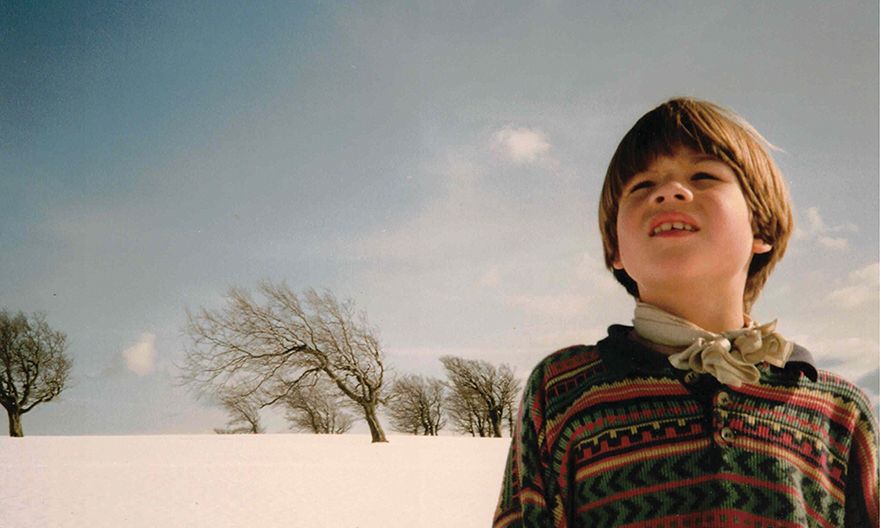A young Julius von Bismarck in 1992 Courtesy of Hatje Cantz Verlag
“The more of a fucked-up childhood you have, the better artist you become because you have something to work with,” declares the performance art superstar Marina Abramović in a new book about artists and their early years. “I don’t know any great artists who had a happy childhood.” This assertion, alongside remarkable details about the artist’s own strange and traumatic childhood, are revealed in the first chapter of Dream On Baby: Artists and Their Childhood Memories by the Berlin-based curator, art critic and author Gesine Borcherdt.
In her first-person account, Abramović tells of her cold and abusive mother, her philandering father and her epileptic brother. She relays a story about her father teaching her to swim by dropping her into the Adriatic Sea and rowing away while she nearly drowned. “This heavy story haunted me for a very long time; it is the heaviest of all. It took me about 50 years to overcome it,” Abramović says. “But at the same time, this is what kept me going and created my work.”
Dream On Baby offers a glimpse into the most intimate details of the early lives of 33 artists, including Ai Weiwei, Mona Hatoum, Jeff Koons, Kader Attia, Mike Nelson and Julius von Bismarck. Accompanying each text are images of the artists when they were young and “early works” (childhood drawings and creations), many of which have never been published or shown in public before. Borcherdt has known some of the artists for many years, while others she interviewed especially. “I felt that this topic didn’t have enough space in articles or catalogue texts, so I wanted to give it more attention,” she says.
A spread from Dream On Baby featuring Marina Abramović
Borcherdt believes that all artists and their work are influenced by their childhood in one way or another and she herself pinpoints a key figure in her childhood—a free-spirited friend of her mother—who inspired her to become a writer and curator. Over her 20-year career in the art world she has discussed the subject repeatedly with the artists she has worked with. “They all had a story to tell—even those who prefer not to share it in public,” Borcherdt says. The topic inspired her to organise the exhibition Dream Baby Dream at Haus Mödrath – Räume für Kunst, near Cologne, in 2020. The book builds on the show’s subject matter, including some of the same artists such as Jean-Marie Appriou, Richard Billingham and Valie Export.
The real-life stories in Dream On Baby seem to cover the spectrum of human emotion—some are funny and heartwarming while others are tragic and disturbing. It is surprising how directly the relayed experiences seem to correlate with artists’ careers and practices. Ai talks about the harsh conditions he lived under when his family were exiled to northern China (after one of the Communist Party’s purges targeted his poet father), which ultimately led him to a create work centred on human rights and freedom of expression. Billingham grew up in a poor, run-down household with parents who neglected him, leading him to find beauty in seemingly ugly, everyday objects and situations. Attia lived in severe poverty in Algeria and in the Paris banlieues, which he escaped—in his mind at least—by looking at art books in the library.
Abramović’s ominous opening quote certainly rings true in many of the stories about the artists, with most relaying difficult upbringings. Borcherdt admits that in almost every childhood story there was something “off”. She explains: “One sentence I heard repeatedly, no matter how intense the story, was ‘I thought that was normal’. Psychologists might hear that often, but art historians certainly don’t.”
A painting by Jon Rafman when he was around ten years old, before he moved into digital art
Courtesy of Hatje Cantz Verlag
But some stories, such as Jon Rafman’s, tell of loving and supportive childhoods that had an impact on the artists in different but equally strong ways. “There are some incredible anecdotes particularly about mothers,” Borcherdt says. Rafman starts his chapter with the line “I am a proud mama’s boy” and adds “I was raised by a brilliant, eccentric single mother with whom I have a deep bond beyond words.” For Borcherdt, the running theme of the book is not about sad childhoods but rather that “no matter if their childhood was ‘fucked-up’ or actually fine, [the artist’s] are able to transform the unbearable into beauty”.
There are many more artists Borcherdt would have liked to include, she says, such as Tracey Emin, Yayoi Kusama, David Hammons and Paul McCarthy. “Richard Serra or Bruce Nauman would have been fascinating too, but especially male artists of the older generation prefer to let the work speak for itself, while women are more open,” Borcherdt says. “A few artists with amazing stories backed out because they suddenly felt uncomfortable seeing their words printed.” Going forward, she hopes to do more on the subject, including writing further and curating more exhibitions. “There are so many more childhood stories out there,” she says, “and by having done this book, they seem to keep coming through my door.”
• Gesine Borcherdt, Dream On Baby: Artists and Their Childhood Memories, Hatje Cantz Verlag, 352pp, £38 (hb)

